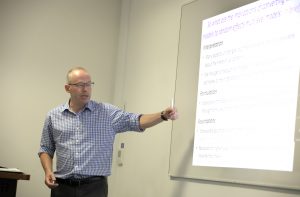Please note: This course will be taught in hybrid mode. Hybrid delivery of courses will include synchronous live sessions during which on campus and online students will be taught simultaneously.

Paul Lambert is a Professor of Sociology at the University of Stirling, UK, where he teaches courses on research methods and on social stratification at undergraduate and postgraduate level. He is the director of three related Masters courses on social research methodology in his institution, and he is a member of the Scottish Graduate School in Social Science postgraduate ‘training network’, delivering advanced training to PhD students across Scottish institutions. His research covers methodological topics in social survey data analysis and data management (with a particular interest in handling data on occupations), and applied research on processes of social stratification and social inequality in selected areas (recent funded projects include analysis of workplace changes and their relationship to changes in health and well-being; and survey data analysis of social inequalities experienced by Lesbian, Gay and Bisexual people in the UK).
Course Description
Become fluent in using important tools of applied social statistics including: Multilevel models – Categorical outcomes models – Marginal effects – Panel models for longitudinal data – Selection models.
This course helps participants to widen their knowledge and experience of applied social statistics. The programme introduces topics that are related to using regression modelling approaches in relatively sophisticated ways. It features accessible introductions to the theory and procedures involved in implementing selected tools of analysis, with lots of examples that use real world social survey (or survey-like) datasets.
Course Content
- Multilevel models
- Marginal effects
- Categorical outcomes models
- Sampling design and weighting adjustments
- Panel models for longitudinal data
- Missing data
- Comparing fixed and random effects models
- Estimating and representing uncertainty
- Selection models
- Causal interpretations of model results
- Measurement models
- Learning from simulated data
- Workflow and documentation considerations
Course Prerequisites
The course can be thought of as an accessible introduction to selected advanced issues. Concepts, basic algebraic formulae, software training, and extension issues and debates will all be introduced in ways that focus on the social science contribution of the method.
It is expected that participants will have had some previous training in social statistics, for example on popular descriptive analytical techniques (e.g. chi-square tests; correlation values) and well-known types of regression models (e.g. multiple regression, logistic regression). Teaching sessions include some recap content, but concentrate on introducing the specialist topics listed above.
The course is best suited to participants with some previous experience in using Stata code or ‘syntax’. Course materials include some introductory resources, but students without any background in using Stata syntax should be prepared that extra effort will be needed near the start of the course in order to make good use of the lab exercises.
Representative Background Readings
Specific background study prior to attending the module is not required. During the course, texts by Long & Freese and by Rabe-Hesketh and Skrondal are used regular and made available to participants, and numerous other readings are recommended for further study.
- Long, J.S. & Freese, J. (2014) Regression Models for Categorical Dependent Variables Using Stata, Third Edition, Tx: Stata Press [ISBN: 9781597181112]
- Sophia Rabe-Hesketh and Anders Skrondal, Multilevel and Longitudinal Modeling Using Stata, Fourth Edition (2-volume set), ISBN: 978-1-59718-136-5 (provided by ESS)
Before the course begins, participants might benefit from revising any text on basic statistical methods in the social sciences that has coverage of descriptive statistics and multiple regression models. We recommend:
- Kohler, H. P., & Kreuter, F. (2012). Data Analysis using Stata, 3rd edition. College Station, Tx: Stata Press.
- Treiman, D. J. (2009). Quantitative Data Analysis: Doing Social Research to Test Ideas. New York: Jossey Bass. (Chpts 1-7)
Software
All topics are elaborated upon with multiple illustrative examples using Stata. We focus on Stata since it is well-equipped to support the topics and datasets being addressed. Introductory materials are available to participants with limited Stata experience whilst students completing the course can expect to develop relatively advanced Stata programming skills. Selected materials are also made available using SPSS and R, mainly for the purposes of comparative assessment of different software tools. Also of relevance:
- Whilst practical lab sessions are centred on exercises that use Stata, other lecture and study materials are normally software-independent. Nevertheless most statistical outputs within lectures will have been generated via Stata, and lecture contents occasionally address issues that are specific to Stata.
- Some participants are likely to be fluent in using Stata already. Extensive prior experience with Stata is not required, but it would be difficult to make good use of course materials without some previous exposure to using Stata ‘syntax’ code.
Background Knowledge
Maths:
Calculus – Elementary
Linear Regression – Elementary
Statistics:
OLS – Elementary
Software:
Stata – Elementary



